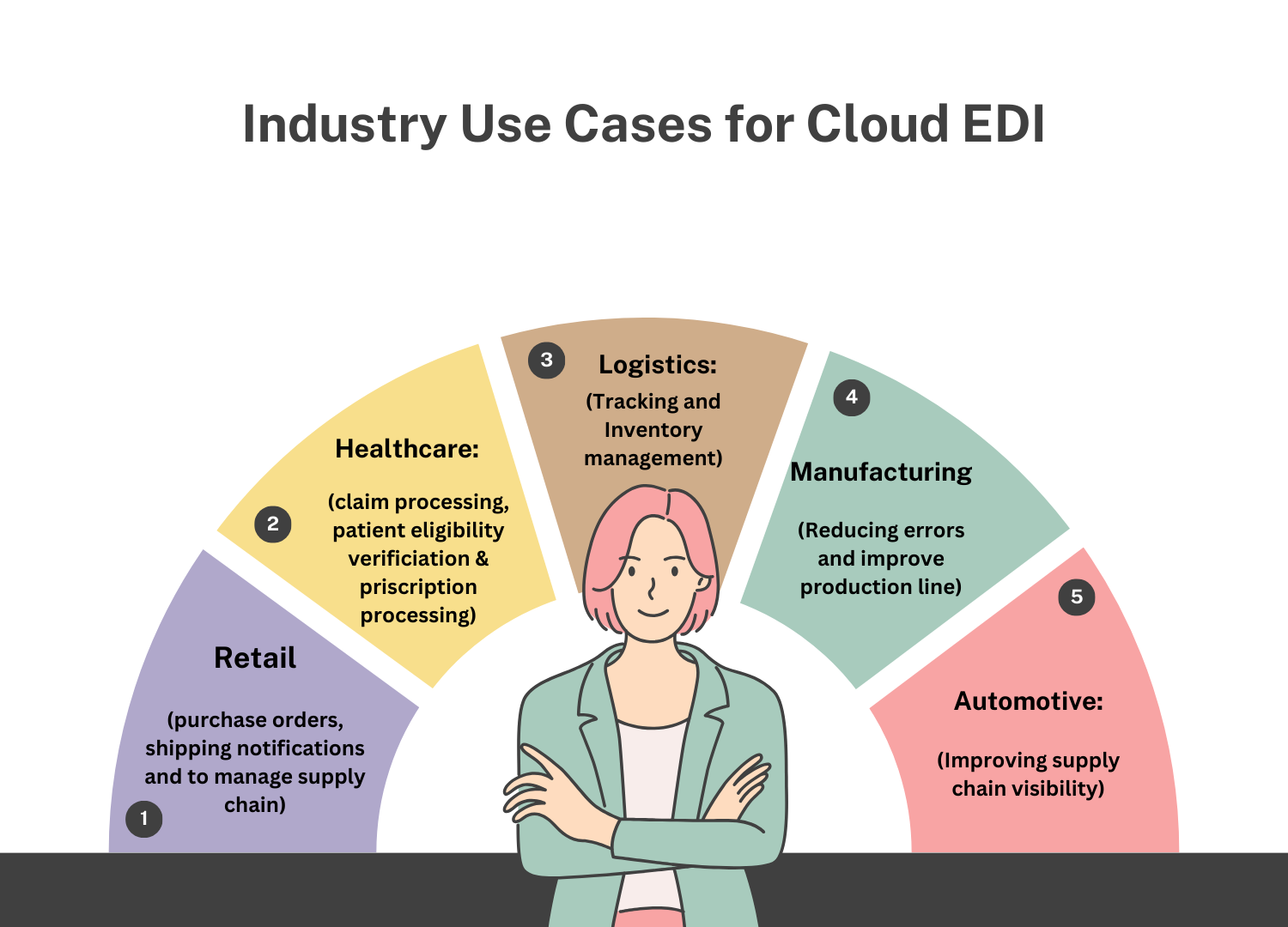Table of Contents
Today, the way businesses operate is shifting thanks to new tech. Paper and manual tasks are becoming a thing of the past. Now, firms turn to digital tools to be quicker, save effort, and plan better. In 2020, people spent a whopping $1.3 trillion on these tech aids, according to IDC data. But this isn’t just for fun gadgets. It’s reshaping the way companies talk with each other and their clients. It also affects how they meet their goals. At the center of this change is Electronic Data Interchange or EDI. What is EDI, you ask? EDI helps companies send data to each other digitally without needing a person to do it. Think of it as a shared language that different business systems use to communicate easily. Also, with projections showing that the worldwide EDI market will hit $4.52 billion by 2030, according to Fortune Business Heights, it’s clear that an increasing number of businesses are seeing its value.
So why are people paying more attention to EDI? First, it cuts down on mistakes that come from entering data by hand, ensuring that transactions are accurate and timely. On top of that, as business transactions become more complicated and abundant, EDI stands as a sturdy way to handle and sort data quickly.
As we explore EDI further, an emerging trend is taking shape: Migration to Cloud EDI. This fresh take combines the benefits of cloud computing with the tried-and-true methods of traditional EDI. It gives businesses a solution that’s flexible, easy to scale, and easy on the wallet. Also, exchanging business papers in real-time, anywhere around the globe, without sinking money into expensive tech setups. That’s the edge Cloud EDI from top EDI providers delivers.
Ready to Migrate to the Cloud?
Explore Our Cloud EDI Services
What is Cloud EDI?
Today, everyone wants quick and clear communication. That’s where Cloud EDI shines. It lets businesses send data fast and without mistakes. This means they save time and money.
Also, many businesses today want smooth and quick data sharing. That’s why they’re looking at an EDI provider. These experts give custom solutions. So, every business, big or small, can use EDI’s many perks.
How It Differs from Traditional EDI Systems
Traditional EDI systems were a big deal when they first came out. But they had some issues. They cost a lot to set up, didn’t grow easily, and didn’t mix well with new tech. Cloud EDI, on the other hand, solves these problems.
With EDI Cloud, spending much on tools or software is unnecessary. It’s all in the cloud. So, businesses can use EDI without worrying about physical stuff. Also, this saves money and lets them grow as needed.
Also, Cloud EDI mixes well with other systems. Whether a Traditional system or a new app, EDI services make the connection smooth. Also, this means businesses can change and grow without big changes to their EDI.
Plus, EDI works in real time. Traditional EDI systems took time, working in groups. But with EDI, data moves right away. This keeps businesses quick and ready in our fast digital world.
Traditional EDI systems started the trend of electronic data sharing. But EDI is the next step. It gives businesses the speed, savings, and flexibility they need today. As more businesses see how good it is, more will start using EDI.
Why Businesses Are Turning to Cloud EDI
Cost-effectiveness
A big reason many choose Cloud EDI is because it saves money. Traditional-style EDI systems can be expensive. They often need special equipment, programs, and sometimes even IT experts to run them. These costs, plus the money to keep them working, can be a lot for a company.
But with EDI services, companies pay a regular fee. This means they can use the software and services without paying a lot. Also, with EDI, companies don’t have to think about program updates or keeping the system working. The EDI service companies do this work. This ensures companies always use the newest tools without extra costs.
Accessibility
Today, companies work all around the world and at all hours. They need to get to their data fast, no matter where they are. Traditional-style EDI systems, tied to one place, often can’t do this.
But Cloud EDI is different. Because it’s on the cloud, people can use their EDI software on any device that connects to the internet. This could be a computer at the company’s main office or a phone far away. Also, companies can always communicate with their partners, suppliers, and customers. This helps data sharing happen fast and without problems.
Scalability
All companies change over time. They might start selling in new places, make new items, or get busier at certain times of the year. It’s important to change operations to match these needs. Traditional-style EDI systems, which can’t change easily, often can’t meet these needs.
But EDI Cloud is different. It lets companies change their EDI to match their needs. This could be a new company growing fast or a big company getting ready for a busy time. With Cloud EDI, companies have what they need when they need it. And they only pay for what they use. Also, this helps the system work its best and also saves money.

The Technical Advantages of Cloud EDI
Seamless Integration with Existing Systems
Companies use many software tools today. Tools like ERP help with making products. CRM tools help with customers. But adding new tech to these tools can be hard.
This is where EDI Cloud helps. It easily works with these tools. So, companies can link their Cloud EDI solutions to their ERP, CRM, and more. This makes sharing data easy and error-free. It helps companies work better.
In the USA, this is a big deal. There are many EDI service providers in the USA. Companies can pick the one they like. They can make sure their EDI Cloud works well with their other tools.
Enhanced Data Security
Data leaks and hacks can cost companies money and trust. Cloud EDI helps here.
Cloud-based EDI solutions have top safety features. They lock data when it’s sent. They save copies and can get lost data back. This means companies can trust their data is safe.
Also, the best EDI solution providers keep their systems safe. They update them to fight new threats. So, companies can work without fear.
Real-time Data Exchange and Faster Transaction Speeds
In business, time is money. Small delays can cost a lot. Like waiting to get an order or update stock.
Cloud EDI fixes this. It shares data right away. So, companies can act fast and make smart choices. The cloud is also fast. It lets companies do more work in less time. This makes them work better.
Did you know? A recent survey by TechRepublic revealed that 95% of businesses in the USA plan to increase their investment in Cloud EDI solutions in the next two years, highlighting its growing importance.
Want an Effortless Data Exchange in The Cloud?
Partner With Our Cloud EDI Experts
Potential Challenges and How to Overcome Them
Addressing Concerns About Data Breaches and Technical Errors
Today, data is very valuable. But this value attracts cybercriminals looking for weak spots. Data leaks can lead to big losses and harm a company’s image.
But Cloud EDI, when set up right, is very safe. Top EDI cloud service teams focus on keeping data safe. They use the best ways to lock data and need multiple steps to access it. Also, they often check for weak spots to fix them fast.
Still, mistakes can happen. To lower risks, companies should:
- Always have a copy of their data to get back lost info fast.
- Train their team to use EDI Cloud the right way.
- Work well with their EDI cloud team to fix any issues fast.
Ensuring Consistent Performance Amidst Network Congestion
The cloud lets you access data anytime, from anywhere. But what if the internet is slow or the service stops? This can hurt a business by causing delays and lost sales.
To keep things running well:
- Choose EDI cloud teams that promise almost no downtime.
- Have a second internet line to always access the Cloud EDI.
- Keep an eye on how the system works to fix any issues fast.
Tips for Selecting a Reliable Cloud Provider
Picking the right EDI cloud team is key. Here’s how to choose:
- Track Record: Go with teams that have done well before and have happy customers.
- Safety First: Make sure the team puts safety first. They should lock data, always have a backup, and need multiple steps to access.
- Growth: As you grow, your Cloud EDI needs to change. Pick a team that can change with you.
- Help When You Need: Go with teams that help you anytime.
The Future of Cloud EDI: Trends and Innovations
The Role of Artificial Intelligence and Machine Learning in Optimizing EDI Processes
Artificial Intelligence (AI) and Machine Learning (ML) in EDI are changing the game. When you mix them with Cloud EDI, the benefits are huge:
- Predictive Analysis: AI looks at tons of data and guesses what’s coming next. This means businesses can know what customers want before they even ask!
- Automated Data Entry: ML can remember past EDI tasks. This means less manual work, fewer mistakes, and faster results.
- Optimized Decision Making: With AI techniques, companies can make better decisions. They can grab good chances and avoid problems.
Blockchain’s Promise for Enhanced Transaction Security
Blockchain, the brain behind digital money, can do much for Cloud EDI. It’s built in a way that ensures:
- Tamper-proof Transactions: Once you put data on a blockchain, no one can change it. This means EDI data stays real and safe.
- Transparency: Everyone in an EDI deal can see the data. This builds trust.
- Reduced Costs: With no middlemen, blockchain reduces costs and speeds up deals.
Steps to Successfully Migrate to Cloud EDI
Assessing Your Current EDI Setup
Before you start migrating to Cloud EDI, know where you are now. This will be your roadmap for the switch.
- Capabilities: Check out your current EDI. What’s good about it? What’s not so good? Knowing this will show you what EDI can improve.
- Needs: Every company is different. Maybe you want data right away. Or you need to handle lots of transactions. Also, write down your needs so your new EDI Cloud covers everything.
- Goals: Think about the next few years. Growing your business? Expecting more transactions? Knowing this will make sure your Cloud EDI is ready for the future.
Researching and Comparing Cloud EDI Solutions
Now that you know what you want, see what’s out there.
- Features: Make a list of what you want. From keeping data safe to working with your current systems, pick an EDI that does everything you need.
- Reliability: Even the best features won’t help if the system breaks down. Find EDI options that people trust and like.
- Cost: Cloud EDI can save money, but prices change. Look at different prices, but remember, the cheapest might not be the best. Think about what you’re getting for your money.
Collaborating with Cloud Providers for a Smooth Transition
Migrating to EDI Cloud is big. Teamwork makes it work.
- Open Communication: Have clear chats with your new EDI company. Talk about what you want, any worries, and what you expect. Also, this makes sure everyone knows what’s happening.
- Training: New things can be scary. Work with the company to teach your team. This way, everyone knows how to use the new system.
- Ongoing Support: The move isn’t over once it’s set up. Make sure the company helps out if there are any small problems or questions later on.
Best Practices for Maintaining a Robust Cloud EDI System
Regular Data Backups and Updates
Data is very important today. Businesses run on it, and losing it can be very bad.
- Scheduled Backups: Save your Cloud EDI data often. This means your data is safe if something bad happens, like a system break or a hacker attack. Also, it’s good to have automatic saves, maybe every day or every week, based on how much work you do.
- System Updates: Like all software, EDI Solutions gets new versions. These new versions have better safety and work better. Make sure you use the newest version to get these good points.
Monitoring Network Performance and Making Necessary Adjustments
A Cloud EDI system that works well is key for good business.
- Real-time Monitoring: Use tools that show how your system works. This lets you see and fix problems early.
- Adjustments and Optimizations: Based on what you see, make changes. This might mean more internet speed, better server use, or picking a new service if the one you have isn’t good enough.
Staying Informed About Industry Standards and Compliance Requirements
Following rules isn’t just about doing what you’re told. It’s about keeping your data safe and right.
- Stay Updated: Business rules change. Go to online classes and workshops, or get news about your industry to know the latest.
- Implement Changes: When you know about new rules, use them in your Cloud EDI system. Also, this keeps you in line with the rules and often makes your system safer and better.
Thinking about starting with Cloud EDI?
Talk to A3Logics and begin your journey to a better future.
Conclusion
Switching to Cloud EDI is a big choice for a business. It’s not just about following a trend.
- Do Your Homework: Before changing, businesses should look at what they have now, see what’s missing, and learn about different EDI Managed services.
- Work Together: A good EDI service can easily help businesses switch to EDI. They know a lot and can help businesses get the most from EDI.
- Stay Ahead: The digital world keeps changing. Using EDI means a business is ready for what comes next.
Also, EDI is more than just a popular word. It’s a way for businesses to be ready for the future. The real question is whether businesses should use EDI Cloud and when they will start.






